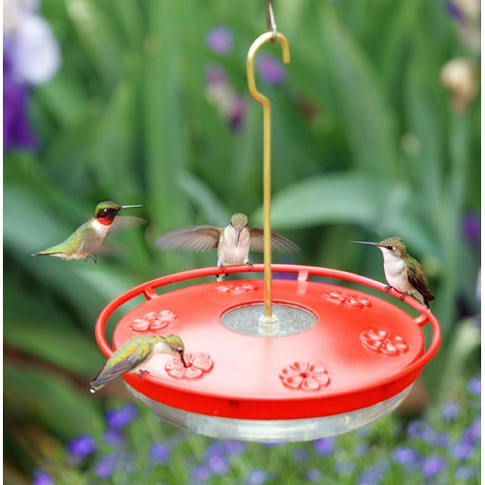Bird Feeding - Choosing the Right Hummingbird Feeder
- Butch
- Apr 7, 2018
- 3 min read

Hummingbird feeders come in so many sizes, shapes, and types that it can be overwhelming when all you want to do is invite a little bird to your yard for a sip. Hopefully, this post will help simplify things and make the task of finding just the right hummingbird feeder a little easier.
There are three primary considerations: 1) decorative or functional, 2) glass or plastic, and 3) tank or saucer. Of course, there are advantages and disadvantages to each style, so ultimately it comes down to personal preference. Not the hummer's preference, but yours. All of the feeders (at least the ones we carry) work equally well in the feeding department, so you can relax knowing that the decision can be based on your preferences and situation.
Decorative vs. Functional. Of all the different types of bird feeders on the market, hummingbird feeders especially are often made to be works of art. Fine cut crystal, curvaceous lines, copper and gold colored embellishments, many are incredibly attractive yard decorations by themselves. However, as I like to say: even an ugly hummingbird feeder will look amazing with a dozen ruby-throated sprites zipping all around it.
When it comes to decorative vs. functional, the key factor is really clean-ability. Decorative models have a tendency to be more difficult to clean; functional models tend to be easier to clean. No hummer wants to drink moldy, fermented nectar, so keeping your feeders clean is the most important thing you can do for them. So you will need to ask yourself if you mind a little work, or if you want cleaning your feeder to be absolutely hassle free? Decorative feeders may need to be pampered a little with brushes or cleaning solutions made just for the task. On the other hand, the best functional feeders often can be tossed on the top rack of the dishwasher and will come out sparkling.
The important part is to know what you are getting yourself into when it comes to clean-ability, so you have no surprises. At the store, take the feeder apart, so you can see how it operates. Look for small crevices and narrow openings that will create hard-to-reach places. Presence of these do not make the feeder "bad", per se, as some people consider the beauty of decorative feeders more than worth the time and effort to clean them; others, however, prefer to rinse, fill, and go. So it's really up to you.
Glass vs. Plastic. While glass can break, it is often easier to clean than plastic, because mold tends to adhere to plastic better than glass. Having said that, the decision about glass or plastic is more about what happens if the wind blows the feeder down or if you have occasional problems with raccoons drinking your nectar. Plastic can usually handle a fall and can usually survive being handled by grubby little paws, too. If you have glass feeders, prevention is usually the best solution and many people bring them in at night to prevent them from getting demolished. So the answer to glass vs. plastic is again dependent on your situation and preferences.
Tank vs. Saucer. Tank feeders are feeders that have the nectar supply held in an inverted tank above the feeding ports, while saucer feeders hold the nectar in a bowl under the feeding ports.
The primary benefit of tank feeders is that they come in large capacities (16-80 oz.), which is larger than typical saucer feeders (usually 4-16 oz). This is a benefit if your hummers seem to be draining your feeders as quickly as you can fill them up. Droll Yankees has recently come out with a 32 oz. mega-saucer feeder, so the capacity limitation may be changing.
The primary disadvantage to tank feeders is that sometimes the air pocket in the tank will expand in warmer weather, which can push the nectar up close to the feeding ports. Bees have a tendency to find this nectar supply and can be an occasional nuisance because of this. Saucer feeders usually do not suffer from this issue, because the nectar is held below the feeding ports. Note that many saucer feeders also have built-in ant moats to help reduce, if not eliminate, an ant issue at your feeders. Tank feeders will often require a separate ant moat, but these can be purchased for a nominal amount.
In conclusion...
Selecting a hummingbird feeder doesn't have to be hard decision. Even though we carry over 50 different types, armed with little knowledge you can whittle the options down pretty quickly. Just keep the above choice in mind and you will be well on your way to selecting the feeder that is right for you.
Join me next time when I discuss how to maintain your feeders, so that you and your hummingbirds will enjoy them for years to come.
Happy birding!
Butch































